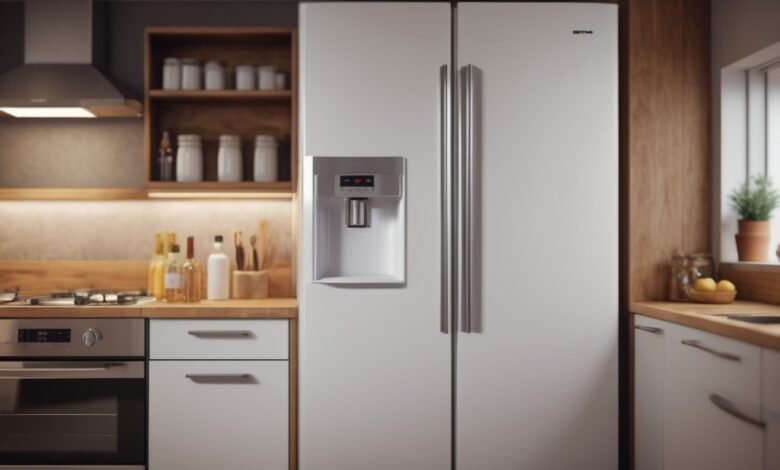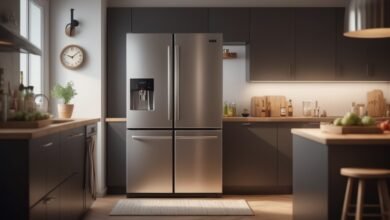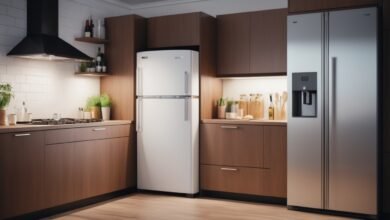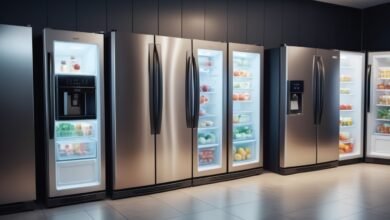High-Tech Refrigerators for a Connected Lifestyle: Redefining the Kitchen Experience

In the dynamic world of kitchen appliances, the evolution of refrigeration technology has been nothing short of remarkable. From the rudimentary iceboxes of the past to the high-tech refrigerators of today, these appliances have undergone a transformative journey. In this comprehensive exploration, we delve into the intricate details of high-tech refrigerators, dissecting their multifaceted features, examining the tangible benefits they bring to our daily lives, and pondering the potential future innovations that might redefine our kitchen experiences.
I. Introduction
A. Evolution of Refrigeration Technology
The history of refrigerators dates back to the early 19th century when iceboxes were used to preserve perishable items. The gradual progression from ice-based cooling to electric refrigeration marked a significant leap in technology. In recent years, high-tech refrigerators have become the epitome of innovation, incorporating advanced features that go beyond mere preservation.
B. The Connected Lifestyle
Our lives are increasingly intertwined with technology, and the kitchen is no exception. High-tech refrigerators, as the focal point of modern kitchens, have embraced connectivity. They seamlessly integrate with other smart devices, creating a synchronized ecosystem that caters to the demands of our fast-paced, interconnected lifestyles.
II. Smart Features
A. Internet of Things (IoT) Integration
The advent of the Internet of Things (IoT) has revolutionized the way we interact with household appliances. High-tech refrigerators leverage this connectivity, allowing users to remotely monitor and control their fridge’s settings. Whether adjusting temperatures, checking inventory, or receiving real-time alerts, the power is at the user’s fingertips through dedicated smartphone apps.
B. Voice Activation
Voice-activated assistants have become a ubiquitous presence in smart homes, and high-tech refrigerators are no exception. The integration of platforms like Amazon Alexa or Google Assistant introduces a hands-free approach to fridge management. Users can effortlessly inquire about contents, add items to shopping lists, or adjust settings, all through natural voice commands.
C. Interactive Touchscreens
The inclusion of interactive touchscreens on refrigerator doors transforms these appliances into command centers. From managing grocery lists to displaying recipes and streaming multimedia content, these touchscreens offer a level of interactivity that was once unimaginable in the realm of kitchen appliances.
D. Automated Inventory Management
Gone are the days of manually keeping track of what’s in the fridge. Smart refrigerators equipped with cameras and sensors provide real-time inventory management. They can identify items, track expiration dates, and even suggest recipes based on available ingredients, streamlining the meal planning process.
III. Energy Efficiency
A. Smart Temperature Control
Traditional refrigerators often operate on fixed temperature settings, leading to inefficiencies. High-tech refrigerators, however, employ smart temperature control systems. These systems adapt to usage patterns, adjusting temperatures dynamically to optimize energy consumption while maintaining optimal conditions for food storage.
B. Energy Star Certification
Energy efficiency is a cornerstone of high-tech refrigerators, many of which proudly bear the Energy Star certification. This designation signifies a commitment to reducing environmental impact by utilizing technologies that consume less energy. LED lighting, a common feature in these refrigerators, contributes to overall energy savings.
IV. Enhanced Food Preservation
A. Precision Cooling Technology
Preserving food at optimal temperatures is crucial for prolonging freshness. High-tech refrigerators employ precision cooling technology, ensuring even and consistent temperatures throughout the various compartments. This precise control safeguards different types of food, from meats to delicate fruits and vegetables.
B. Humidity Control
To address the specific needs of different types of produce, high-tech refrigerators often feature humidity-controlled compartments. These adjustable settings create microenvironments that mimic the ideal conditions for vegetables, fruits, and other perishables, extending their shelf life and reducing food waste.
C. Air Purification Systems
Unpleasant odors and bacteria are common challenges in refrigerators. High-tech models combat these issues with integrated air purification systems. Utilizing advanced filters, these systems remove unwanted smells and maintain a hygienic environment, ensuring that stored food remains fresh and uncontaminated.
V. Entertainment and Connectivity
A. Multimedia Integration
The kitchen has evolved into a multifunctional space where cooking meets entertainment. High-tech refrigerators contribute to this shift by featuring built-in multimedia capabilities. Streaming services, music players, and even video playback options turn the refrigerator into a source of entertainment while culinary endeavors unfold.
B. Family Hub
The concept of a “family hub” is a testament to the role high-tech refrigerators play in fostering family communication. Serving as digital command centers, these appliances facilitate family coordination through shared calendars, digital notes, and even video calls. The refrigerator becomes a central hub for communication in the heart of the home.
VI. Security and Privacy Considerations
A. Data Protection
The increasing connectivity of high-tech refrigerators raises valid concerns about data security and privacy. Manufacturers must prioritize robust cybersecurity measures to safeguard user data from unauthorized access and potential breaches. Encryption protocols and secure authentication mechanisms become crucial elements in protecting sensitive information.
B. User Authentication
To enhance security, some smart refrigerators incorporate advanced user authentication methods. Fingerprint recognition, facial recognition, or even voice recognition add an additional layer of protection, ensuring that only authorized users can access and control the refrigerator’s settings and sensitive information.
VII. Future Trends and Innovations
A. Artificial Intelligence Integration
Looking ahead, the integration of artificial intelligence (AI) is poised to redefine the capabilities of high-tech refrigerators. AI algorithms can learn user preferences over time, predict consumption patterns, and optimize energy usage accordingly. This evolution promises a more personalized and efficient user experience.
B. Sustainable Materials and Design
Sustainability is an ever-growing concern, and future high-tech refrigerators are likely to address this by incorporating eco-friendly materials and designs. Manufacturers may explore innovative solutions, such as recyclable components and energy-efficient cooling systems, to reduce the environmental footprint of these essential kitchen appliances.
VIII. Conclusion
In conclusion, high-tech refrigerators represent a quantum leap in the evolution of kitchen appliances. From their humble origins as basic cooling devices, they have morphed into intelligent, connected hubs that redefine our kitchen experiences. The integration of IoT, smart features, energy efficiency, and advanced preservation technologies not only enhances the preservation of our food but also transforms the kitchen into a dynamic, interactive space.
As we gaze into the future, the convergence of artificial intelligence, sustainability, and seamless connectivity holds the promise of even more exciting innovations in high-tech refrigeration. Embracing these technological marvels not only makes our daily lives more convenient but also sets the stage for a kitchen experience that is more efficient, sustainable, and intricately connected. The high-tech refrigerator is not just a utility; it’s a testament to the boundless possibilities that technology brings to our homes, reshaping the way we live, eat, and connect with our families.






